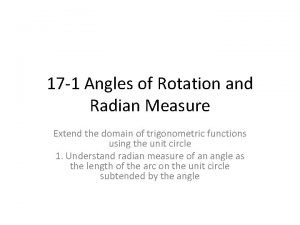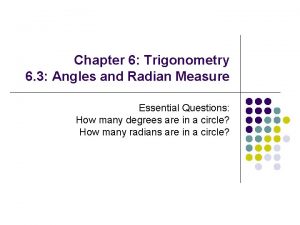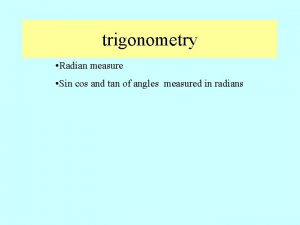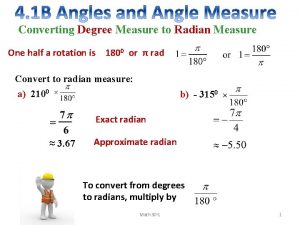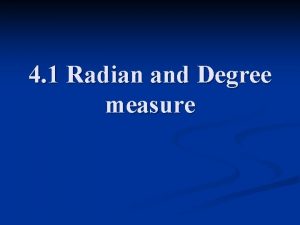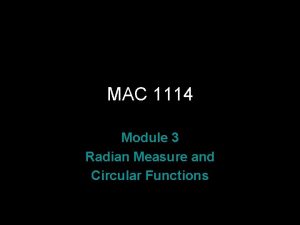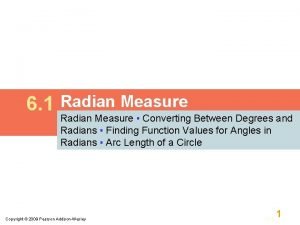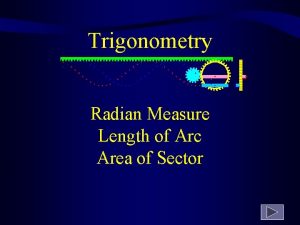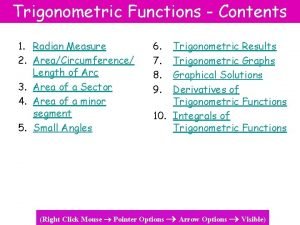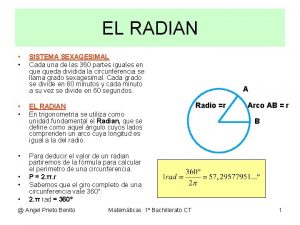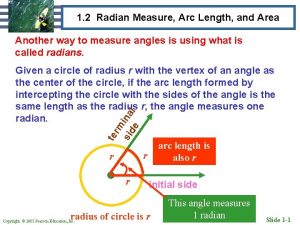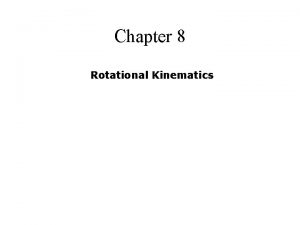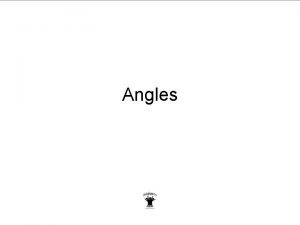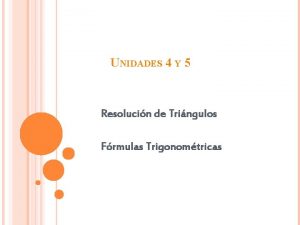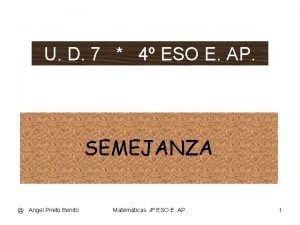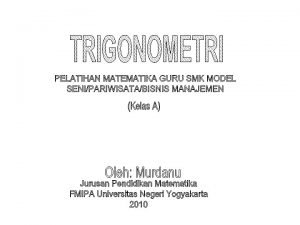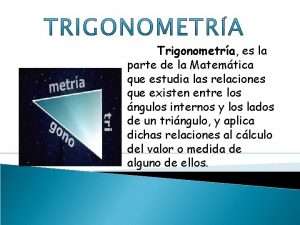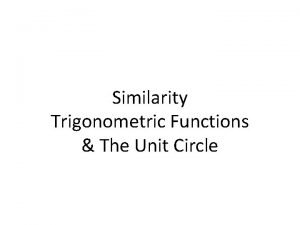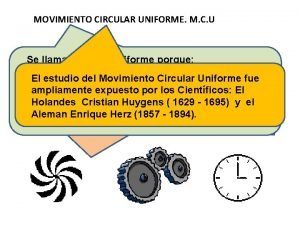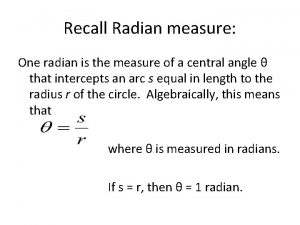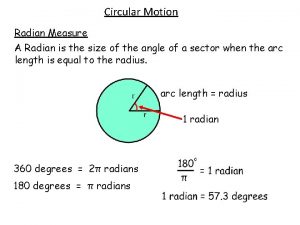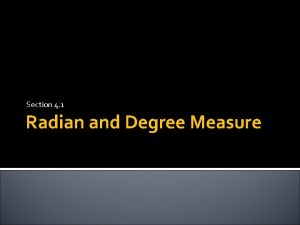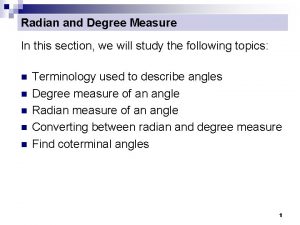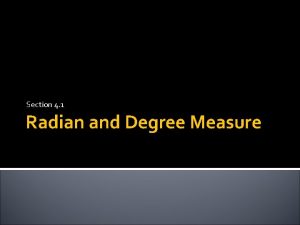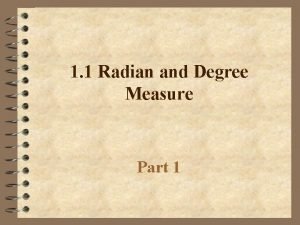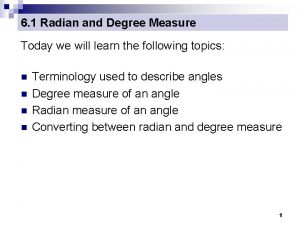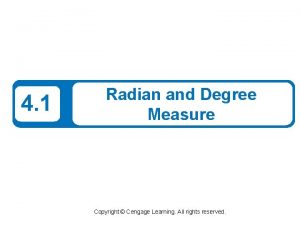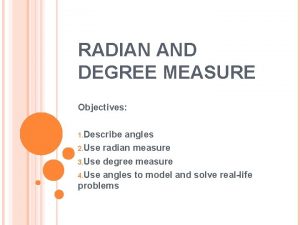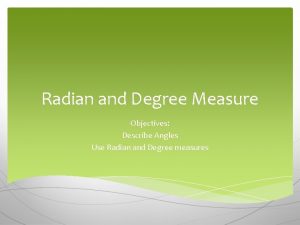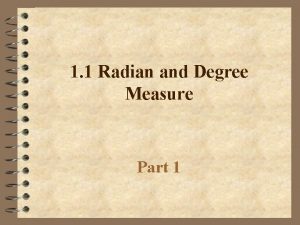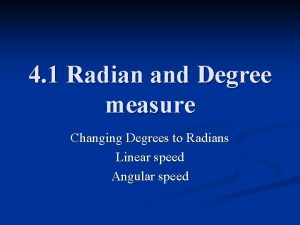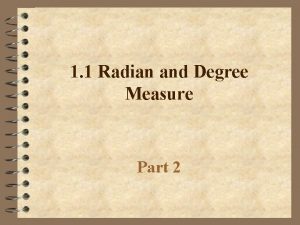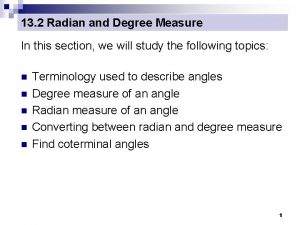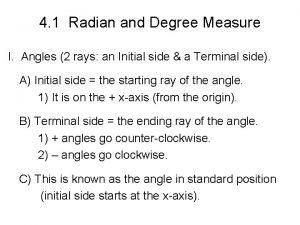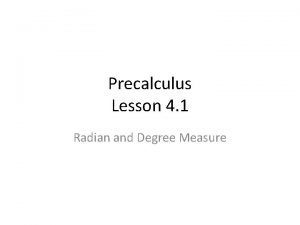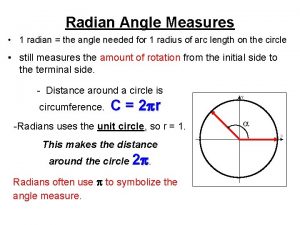Radian and Degree Measure In this section we































- Slides: 31

Radian and Degree Measure In this section, we will study the following topics: n n n Terminology used to describe angles Degree measure of an angle Radian measure of an angle Converting between radian and degree measure Find coterminal angles 1

Bellwork 2

Radian and Degree Measure Angles Trigonometry: measurement of triangles Angle Measure 3

6. 1 Radian and Degree Measure Standard Position: An angle is in standard position when its vertex is at the origin and its initial side lies on the positive x-axis. Vertex at origin The initial side of an angle in standard position is always located on the positive x-axis. 4

Radian and Degree Measure Positive and negative angles When sketching angles, always use an arrow to show direction. 5

6

7

6. 1 Radian and Degree Measuring Angles The measure of an angle is determined by the amount of rotation from the initial side to the terminal side. There are two common ways to measure angles, in degrees and in radians. We’ll start with degrees, denoted by the symbol º. One degree (1º) is equivalent to a rotation of one revolution. 8

Radian and Degree Measuring Angles 9

Radian and Degree Measure Classifying Angles are often classified according to the quadrant in which their terminal sides lie. Ex 1: Name the quadrant in which each angle lies. 50º Quadrant 1 208º Quadrant 3 -75º Quadrant 4 III IV 10

Radian and Degree Measure Classifying Angles Standard position angles that have their terminal side on one of the axes are called quadrantal angles. For example, 0º, 90º, 180º, 270º, 360º, … are quadrantal angles. 11

Radian and Degree Measure Coterminal Angles that have the same initial and terminal sides are coterminal. Angles and are coterminal. 12

Find one positive angle and one negative angle that are coterminal with (a) − 45° and (b) 395°. There are many such angles, depending on what multiple of 360° is added or subtracted. 13

Radian and Degree Measure Example of Finding Coterminal Angles You can find an angle that is coterminal to a given angle by adding or subtracting multiples of 360º. Ex 2: Find one positive and one negative angle that are coterminal to 112º. For a positive coterminal angle, add 360º : 112º + 360º = 472º For a negative coterminal angle, subtract 360º: 112º - 360º = -248º 14

Ex 3. Find one positive and one negative angle that is coterminal with the angle = 30° in standard position. Ex 4. Find one positive and one negative angle that is coterminal with the angle = 272 in standard position.

Radian and Degree Measure Radian Measure A second way to measure angles is in radians. Definition of Radian: One radian is the measure of an angle in standard position whose terminal side intercepts an arc of length r. In general, 16

Radian and Degree Measure Radian Measure 17

Radian and Degree Measure Radian Measure 18

19

Radian and Degree Measure Conversions Between Degrees and Radians 1. To convert degrees to radians, multiply degrees by 2. To convert radians to degrees, multiply radians by 20

Ex 5. Convert the degrees to radian measure. a) 60 b) 30 c) -54 d) -118 e) 45

Ex 6. Convert the radians to degrees. a) b) c) d)

Bellwork Convert the degrees to radian measure. 1. 30 2. -54 Convert the radians to degrees. 3. 4. 23

24

Ex 7. Find one positive and one negative angle that is coterminal with the angle = in standard position. Ex 8. Find one positive and one negative angle that is coterminal with the angle = in standard position.

Degree and Radian Form of “Special” Angles 90 ° 120 ° 60 ° 135 ° 45 ° 150 ° 30 ° 0° 180 ° 360 ° 210 ° 330 ° 225 ° 315 ° 240 ° 300 ° 270 ° 26

Find one postive angle and one negative angle in standard position that are coterminal with the given angle. 5. 135 6.

Bellwork Convert from degrees to radians. 1. 54 2. -300 Convert from radians to degrees. 3. 4.

A sector is a region of a circle that is bounded by two radii and an arc of the circle. The central angle θ of a sector is the angle formed by the two radii. There are simple formulas for the arc length and area of a sector when the central angle is measured in radians. 29

A softball field forms a sector with the dimensions shown. Find the length of the outfield fence and the area of the field. 30

In Exercises 33– 38, use a calculator to evaluate the trigonometric function. 31
 17.1 angles of rotation and radian measure
17.1 angles of rotation and radian measure 6-1 angles and radian measure answers
6-1 angles and radian measure answers Sin cos radian
Sin cos radian Radian measure
Radian measure 1 radian
1 radian What weather instrument measures air temperature
What weather instrument measures air temperature Radiation pattern lobes
Radiation pattern lobes Is measure for measure a comedy
Is measure for measure a comedy Convert each degree measure into radians
Convert each degree measure into radians S=rθ examples
S=rθ examples Is hcn polar or nonpolar
Is hcn polar or nonpolar Arc area radians
Arc area radians Area of sector radians
Area of sector radians Metode mengikat kemuka
Metode mengikat kemuka Cada radian se divide en 60 minutos
Cada radian se divide en 60 minutos Arc length formula radians
Arc length formula radians Trigonometri pengukuran sudut
Trigonometri pengukuran sudut Unit of angular acceleration
Unit of angular acceleration Common vertex
Common vertex Movimiento parabolico
Movimiento parabolico Pengurangan derajat menit detik
Pengurangan derajat menit detik đổi radian sang độ trong excel
đổi radian sang độ trong excel Que es un radian
Que es un radian Que es un radian
Que es un radian 405 derajat sama dengan ....... radian
405 derajat sama dengan ....... radian Formula radian
Formula radian Unit circle
Unit circle Formula radian
Formula radian Mcu
Mcu Radian research inc
Radian research inc Section line symbol
Section line symbol Chemical potential energy images
Chemical potential energy images
